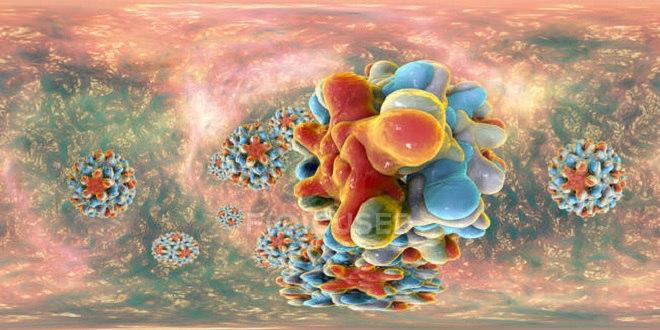Hepadnaviruses: Hepatitis B Virus and Hepatitis D Virus

A hepatitis B virus (HBV) infection (see p. 385ff., replication) of the liver cells results in the expression of viral antigen on the cell surface, followed by immunological cell damage with acute, possibly fulminant, chronic persistent or chronic aggressive hepatitis. The final stages can be liver cirrhosis or hepatocellular carcinoma. A concurrent or later superinfection by a defective, RNA-containing, and HBV-dependent hepatitis D virus (HDV, delta agent) normally exacerbates the clinical course.
Both viruses are transmitted in blood or body fluids, whereby even a tiny amount of blood may be enough to cause an infection. Diagnosis: immunological antigen or antibody assay in patient serum. The antigen or antibody patterns observed provide insights on the stage and course of the disease. Prevention: active immunization with HBV surface (HBs) antigen; concurrent postexposure passive immunization.
cellular double lipid layer in which are integrated the hepatitis B surface (HBs) antigen, a 25 kDa polypeptide, and its precursor stages PreS1 (40 kDa) and PreS2 (33 kDa). (Fig. 8.10). This envelope encloses the actual capsid, which consists of the hepatitis B core (HBc) antigen with 21 kDa and contains the genome together with the DNA polymerase (a reverse transcriptase, p. 385). The complete, infectious virion, also known as a Dane particle after its discoverer, has a diameter of 42 nm, the inner structure 27 nm.
Pathogenesis and clinical picture
The virus replicates in liver cells. The Dane particles and the HBs antigen, but not the HBc antigen, are released into the bloodstream, whereby the HBs antigen is present in two different forms, a filamentous particle of approximately 22 ! 100 nm and a spherical form with a diameter of about 22 nm. A further viral protein is the HBe antigen, which represents a posttranslational, truncated form of the HBc antigen and is no longer capable of spontaneous capsid formation.
It is also released from the hepatic cells into the blood. Hepatitis B Mutants Using molecular biological methods refined in recent years, more and more HBV mutants have been found with one or more amino acid exchanges in certain proteins. HBs or PreS mutants are so-called “escape” mutants that can cause a new infection or recidivation despite immune protection by antibodies to HBs. health
Similarly, pre-HBVc or HBVc mutants can lead to a reactivation of HBV replication and thus to chronic hepatitis, since they block the formation of the HBe antigen and thus the point of attack for the cellular immune defenses. These HBc mutants are frequently observed under interferon therapy.
Hepatitis D pathogen. A certain percentage of HBV-infected persons, which varies geographically, are also infected by a second hepatitis virus discovered at the end of the seventies in Italy, the delta agent or hepatitis D virus (HDV). It was originally thought to be a new HBV antigen. In fact, it is an unclassified RNA virus that codes for the delta antigen.
Its capsid consists of HBs antigen, i.e., HBV-coded material. For this reason, the virus can only replicate in persons infected with HBV (in this case the “helper virus”). The delta agent is 36 nm in size and possesses a very short viral RNA containing 1683 nucleotides. This RNA is circular, has antisense (minus) polarity, and is reminiscent in size and structure of the RNA in plant viroids (p. 472f.).
Last word
Its transcription and replication take place in the cell nucleus by means of a cellular polymerase. The resulting RNA sense strand contains, in contrast to viroids, a protein-coding segment comprising about 800 nucleotides, which the cell processes into an mRNA. The HDV codes for two proteins with 27 and 29 kDa (delta antigen).





